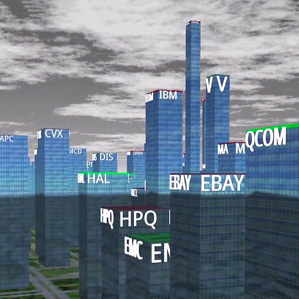Fidelity’s Oculus App Lets You Fly Through Your Investments
Hedging the possibility that Oculus Rift’s immersive goggles might someday become useful beyond video games, Fidelity Investments has mocked up a way for you to don the clunky eyewear and fly through your money.

In Fidelity’s prototype virtual environment—which it says is the first financial services app written for Oculus—stocks are represented as office towers and lumped together in sector “neighborhoods.” The buildings’ footprints are shaped by trading volume and their rooftops are red or green depending on changes in price.
Fidelity is not claiming to have solved any actual problems with the app. But with $2 trillion under management, it wants to get ahead of how new interfaces might be used. “We have a hypothesis that virtual reality will take off in the consumer set in the next three to five years, so therefore we want to understand the technology,” says Hadley Stern, vice president at Fidelity Labs, a research wing of the brokerage company. “We want to get their feedback on this and start to think: how would active traders and other investors use virtual worlds to understand data?”
The company is unveiling the app, called StockCity, this week at a trade show for stock traders in Las Vegas.
Oculus, bought by Facebook earlier this year for $2 billion (see “10 Breakthrough Technologies: Oculus Rift”), allows wearers to inhabit 3-D worlds. Their head motions translate into different views of scenes. Stern says it’s possible that an Oculus visualization would help traders make decisions or see opportunities based on pricing or trading fluctuations.

Within Fidelity’s prototype Oculus app, buildings change height and shape as they represent stocks and trading volumes.
In Fidelity’s prototype app, there are some other heavy-handed metaphors: when the market’s open, it appears to be daytime in the virtual city; when the market is closed, it’s night. Sunshine or rain indicates the general direction of the market. No word yet on what kind of weather graphics would have been used during the last financial crisis, but Stern joked: “Tornadoes?”
An initial experience wasn’t all that exciting. Donning the heavy googles and feeling slightly disoriented, I hoped to fly through my own 401(k) and get a sense of how bad my various decisions had been over the years.
But for now, Fidelity isn’t letting anyone access actual brokerage accounts until it works out security and user-authentication protocols for goggle-wearers. So all I could do was zoom around a generic downtown portraying the movement of various blue-chip stocks.
The company has done similar experiments with Google Glass and the Pebble smart watch. If the app ever takes off, Stern says, traffic in the virtual streets could represent trading activity, or blue Twitter birds around buildings could indicate social media chatter.
Keep Reading
Most Popular
Large language models can do jaw-dropping things. But nobody knows exactly why.
And that's a problem. Figuring it out is one of the biggest scientific puzzles of our time and a crucial step towards controlling more powerful future models.
The problem with plug-in hybrids? Their drivers.
Plug-in hybrids are often sold as a transition to EVs, but new data from Europe shows we’re still underestimating the emissions they produce.
How scientists traced a mysterious covid case back to six toilets
When wastewater surveillance turns into a hunt for a single infected individual, the ethics get tricky.
Google DeepMind’s new generative model makes Super Mario–like games from scratch
Genie learns how to control games by watching hours and hours of video. It could help train next-gen robots too.
Stay connected
Get the latest updates from
MIT Technology Review
Discover special offers, top stories, upcoming events, and more.